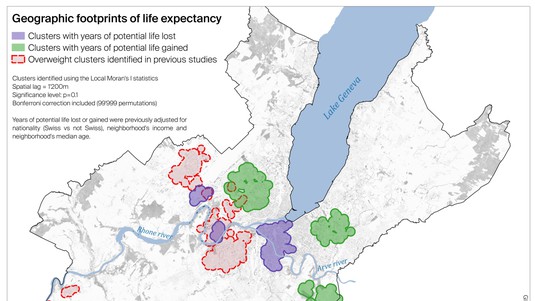Where in Geneva Canton do people live the longest?

This is the first in Switzerland that uses spatial cluster detection methods to investigate life-expectancy inequality at the neighborhood level. © iStock
Scientists at EPFL and Geneva University Hospitals have mapped discrepancies in the difference to life expectancy at birth across Geneva Canton. Their findings shed new light on what researchers previously thought, as the lower-life-expectancy neighborhoods they identified weren’t necessarily those detected in earlier studies.
Switzerland’s life expectancy at birth is one of the highest in the world. According to the Swiss Federal Statistical Office, it stands at 82 for someone born in 2010, up from 71 for someone born in 1960. People’s social class – measured by income and education level – can have a significant influence on their general health and life expectancy. Therefore, when a group of scientists mapped out the difference to life expectancy at birth in Geneva Canton at the individual level, they expected their findings to correlate with socioeconomic factors. That would be consistent with earlier studies in that canton, which showed significant life-expectancy inequality between wealthier neighborhoods and poorer ones, as lower-income, multiethnic neighborhoods scored lower on a variety of public-health indicators. However, to the scientists’ surprise, their map identified other neighborhoods as having shorter life expectancies than expected.
The scientists are from three groups: the Geographic Information Research and Analysis in Population Health (GIRAPH) research group; the Laboratory of Geographic Information Systems (LASIG) at EPFL’s School of Architecture, Civil and Environmental Engineering (ENAC); and Geneva University Hospitals (HUG). Their study, which appears in Scientific Reports, is the first in Switzerland that uses spatial cluster detection methods on individual-level data to investigate life-expectancy inequality.
“Our study shows that geospatial analyses can be a useful tool for examining health inequalities at a local-scale ,” says Anaïs Ladoy, a PhD student at LASIG and the study’s lead author. “These initial findings warrant further research to better understand where the disparities we found come from.” Stéphane Joost, a senior scientist at LASIG and the study’s corresponding author, adds: “We even found that difference to life expectancy at birth can differ significantly from one side of the street to the other.”
Years lost or gained
The scientists measured life-expectancy inequality through a metric called “years of potential life lost or gained,” which is the difference between an individual’s age at death and life expectancy at birth. For example, a man born in Switzerland in 1960 can expect to live to be 71. If he dies later than that, he will have “years gained,” but if he dies earlier, he will have “years lost.” The scientists crunched through some 22,000 death records published in Geneva Canton’s official death notices between 2009 and 2016, and coupled the results with data georeferenced at the deceased’s residential addresses. Their method factored in differences related to nationality, age and gender as well as the demographic and socioeconomic characteristics of the neighborhoods in question.
Unknown factors
“Because our map showed that people in poorer neighborhoods or neighborhoods with lower education levels weren’t necessary those with the most years lost, we believe there are other factors at play,” says Joost. “For instance, someone could have a chronic illness but still live a very long time. Our ‘years of potential life gained or lost’ metric aims to incorporate all the factors people are exposed to throughout their lives, whereas metrics used in earlier studies account for only a small fraction of them.” Joost has been applying some of his research at EPFL for several years now to help officials better target public-health campaigns. Idris Guessous, a chief physician at Geneva University Hospitals who was also involved in the study, adds: “This research on life expectancy supplements earlier findings and provides a precise spatial analysis of health conditions across Geneva Canton – which is one of our main goals at GIRAPH.”
The study takes into account limitations such as the presence of retirement homes in some streets, the nationality of the deceased - which leads to a different life expectancy at birth, but which could not be integrated into the model - or the fact that scientists did not know how long the individuals were living at their final address.

Anaïs Ladoy, Juan R. Vallarta‑Robledo, David De Ridder, José Luis Sandoval, Silvia Stringhini, Henrique Da Costa, Idris Guessous & Stéphane Joost, «Geographic footprints of life expectancy inequalities in the state of Geneva, Switzerland», Scientific Reports, 2 December 2021. DOI : 10.1038/s41598-021-02733-x


